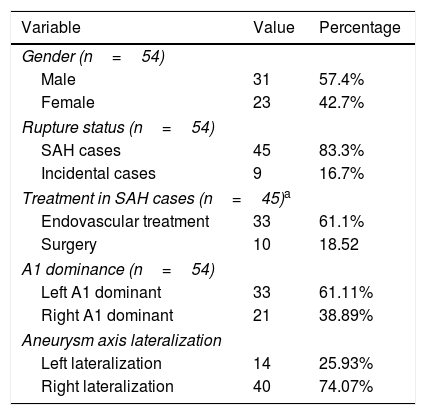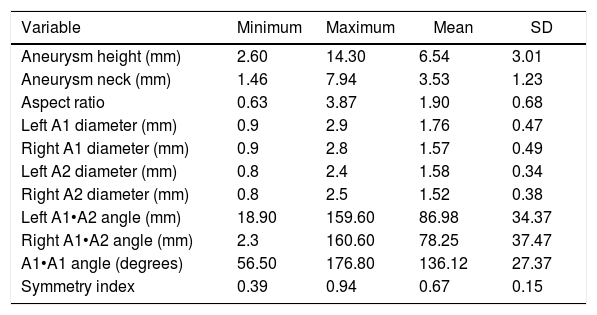The anterior communicating complex is one the most common locations for aneurysm development. It receives blood from both carotid circulations and the effect of synchrony on the arrival of blood flow has not been previously studied. The objective of this study was to compare the asynchrony conditions of the A1 pulse and its effects on the haemodynamic conditions of anterior communicating artery (ACoA) aneurysms.
Materials and methodsFrom 2008 to 2017, 54 anterior communicating artery aneurysms treated at our centre were included in the study. Computational fluid dynamics (CFD) techniques were employed and simulations consisted of complete conditions of synchrony and introducing a delay of 0.2s in the non-dominant A1 artery. Time-averaged wall shear stress (TAWSS), low shear area (LSA), A1 diameter and ACoA angles were measured.
ResultsThe difference in the LSA in conditions of synchrony and asynchrony resulted in a broad range of positive and negative values. The symmetry index (p=0.04) and A1/A2 angle on the dominant artery (p=0.04) were associated with changes in LSA.
ConclusionsIn asynchrony, LSA increased in the absence of A1 asymmetry and low A1/A2 angles, potentially increasing the risk of aneurysm rupture in this location.
El complejo comunicante anterior es una de las localizaciones más frecuentes para el desarrollo de aneurismas; recibe sangre de ambas circulaciones carotídeas y el efecto de la sincronía en la llegada de sangre no ha sido estudiado previamente. El objetivo de este estudio es comparar las condiciones de asincronía del pulso de A1 y sus efectos en las condiciones hemodinámicas de los aneurismas de la arteria comunicante anterior (ACoA).
Materiales y mèc)todosDesde 2008 hasta 2017, 54 aneurismas de la ACoA tratados en nuestro centro se incluyeron en el estudio. Se emplearon tèc)cnicas de dinámica de fluidos computacional y las simulaciones consistieron en condiciones de completa sincronía y en la introducción de un retraso de 0,2s en la arteria A1 no dominante. Se realizaron mediciones del TAWSS, área de bajo cizallamiento (LSA), diámetros de A1 y ángulos de la AcoA.
ResultadosLa diferencia producida en el LSA en condiciones de sincronía y asincronía resultó en un amplio rango de valores positivos y negativos. El índice de simetría (p=0,04) y el ángulo A1/A2 en la arteria dominante (p=0,04) se relacionan con los cambios en el LSA.
ConclusionesEn asincronía, el LSA se incrementó en ausencia de asimetría A1 y ángulos A1/A2 menores, incrementando potencialmente el riesgo de rotura de aneurismas en esta localización.
Article

If it is the first time you have accessed you can obtain your credentials by contacting Elsevier Spain in suscripciones@elsevier.com or by calling our Customer Service at902 88 87 40 if you are calling from Spain or at +34 932 418 800 (from 9 to 18h., GMT + 1) if you are calling outside of Spain.
If you already have your login data, please click here .
If you have forgotten your password you can you can recover it by clicking here and selecting the option ¿I have forgotten my password¿.












